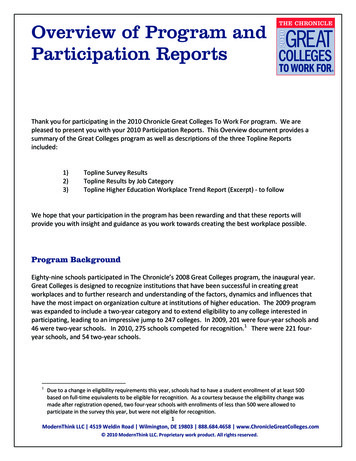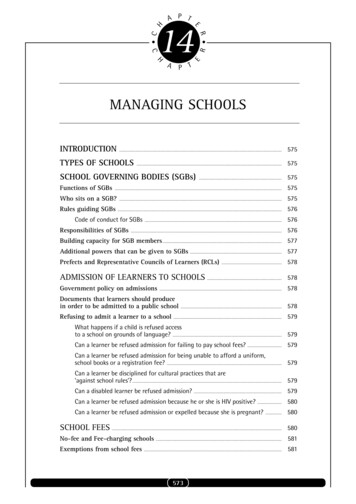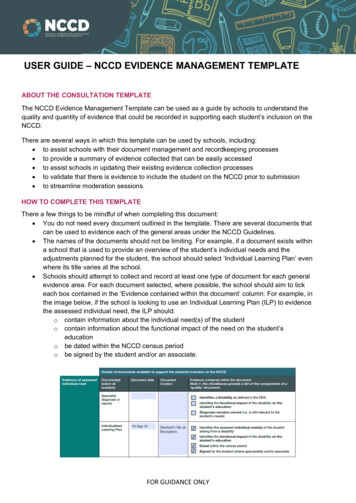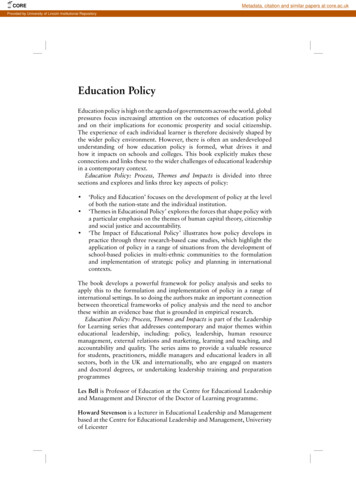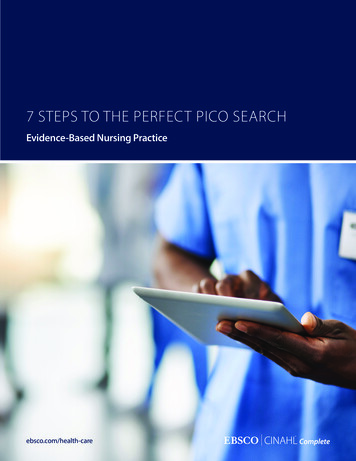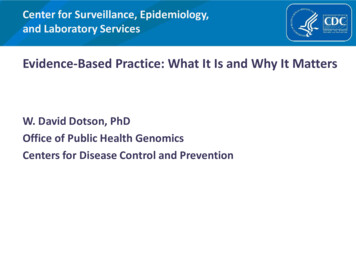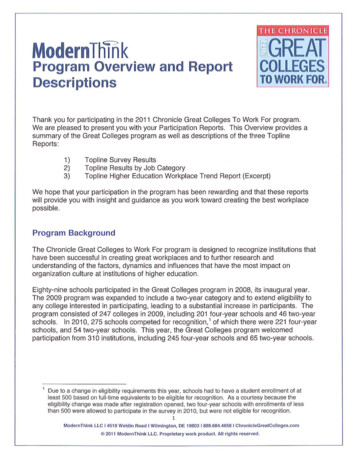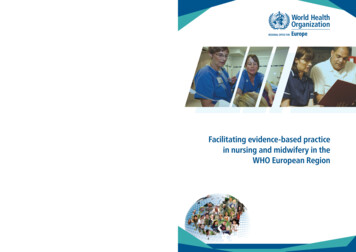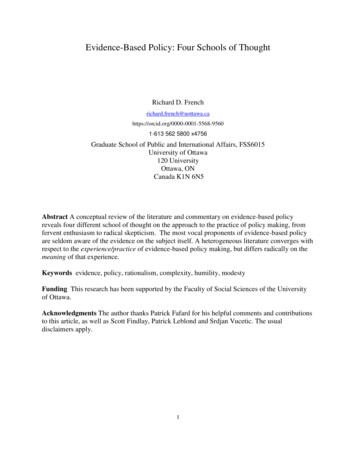
Transcription
Evidence-Based Policy: Four Schools of ThoughtRichard D. 000-0001-5568-95601-613 562 5800 x4756Graduate School of Public and International Affairs, FSS6015University of Ottawa120 UniversityOttawa, ONCanada K1N 6N5Abstract A conceptual review of the literature and commentary on evidence-based policyreveals four different school of thought on the approach to the practice of policy making, fromfervent enthusiasm to radical skepticism. The most vocal proponents of evidence-based policyare seldom aware of the evidence on the subject itself. A heterogeneous literature converges withrespect to the experience/practice of evidence-based policy making, but differs radically on themeaning of that experience.Keywords evidence, policy, rationalism, complexity, humility, modestyFunding This research has been supported by the Faculty of Social Sciences of the Universityof Ottawa.Acknowledgments The author thanks Patrick Fafard for his helpful comments and contributionsto this article, as well as Scott Findlay, Patrick Leblond and Srdjan Vucetic. The usualdisclaimers apply.1
Evidence-Based Policy: Four Schools of ThoughtRichard D. Frenchrichard.french@uottawa.caIntroductionIs the evidence-based policy movement a sign that major improvements in policy-making arethere for the taking, were governments and researchers to make the necessary efforts? Aregovernments currently neglecting evidence which would provide valuable support forsignificantly improved policies? No one doubts that where research usefully addresses publicproblems, it should be exploited to the greatest extent practicable. Not everyone agrees as to (a)how much research “usefully addresses” public problems, (b) how much “the greatest extentpossible” exceeds the current extent to which research is exploited in the making of policy, andtherefore, (c) what efforts should be devoted to achieve a better supply of better employedevidence?We define evidence as the product of research: organized knowledge produced in accord with thestandards of the relevant academic disciplines. Policy is defined as the position or approachadopted by public authorities – governments, agencies, school boards, the military, the police –toward problems or opportunities which are perceived to affect public welfare.This paper attempts to respond to these questions through a conceptual review (Petticrew andRoberts, 2006, 39) of the literature on evidence-based policy making (EBP), developing asynthesis of the research and critique on the performance and potential of EBP. We identify fourmajor schools of thought which differ in their general orientation to the questions raised above.Some commentators on EBP suggest that the definition of “evidence” be broadened to includeother factors which they have come to see as inputs to public policy-making; however, thesesuggestions lose whatever prescriptive power may reside in the EBP idea (Clarence, 2002, 6;Wyatt, 2002, 26).2
An important literature moves from the often contested status of evidence (Barker and Peters,1993, 4; Boswell, 2014; Boyd, 2013, 160; Cairney, 2016, 42-3; Daviter 2015; Lewis, 2003, 10;McCall, 1984, 10; Newman, 2017, 217-8; Parkhurst, 2016, 3-103; Raedelli, 1995; Strassheim,2017; Strassheim and Kettunen, 2014; Topf, 1993, 103-106) to alleged technical and politicalbias in the production and use of organized knowledge in policy-making (Clarence, 2002, 5;Hammond et al, 1983, 290-2; Levidow and Papaioannou, 2016; Monaghan, 2010, 1, 8;Newman, 2011, 481-2; Newman and Head, 2015, 385; Neylan, 2008, 13; Pawson, 2006, 175;Pollitt, 2006, 262; Rein, 1976, 33-4; Sanderson, 2002, 5; Stevens, 2011; Wagner and Steinzor,2006). It is clear that “science” and “evidence” can be used more or less benignly to shieldpolicy processes from the pressure of interest group politics (Bocking, 2004, 21, 169; Hilgartner,2000, 42-85; Jasanoff, 1990; Salter, 1988, 9, 196) as well as, sometimes cynically, to attempt tolegitimize a decision arrived at on other grounds (Boswell, 2008; Byrne, 2011, 99-119; Ezrahi,1980; Hertin et al, 2009; Kissinger, 1969, 164; Lynn, 2001, 210-1; Maybin, 2016, 90-2, 123-5;Newman, 2017; Nutley et al, 2007, 51-3; Shils, 1987, 199, 201; Weiss, 1979, 429). This paperfocuses primarily on studies of good faith attempts to operationalize the EBP idea; we thereforedo not pursue the exploitation of evidence in realpolitik any further, although a species of itreappears in our discussion toward the end of the paper.It is important to note that just as scientific papers do not provide an account of the process ofresearch (Bijker et al, 2009, 28; Hilgartner, 2000, 29; Vaughan and Buss, 1998, 46-7) with itsfalse starts, negative results, and sheer failures, but rather an account of its results, so too doaccounts of policy fail to provide any sense of the process of arriving at that policy, with itsmany reversals, “irrationalities”, and contingencies (Bogenschneider and Corbett, 2010, 153-71;Cleevely, 2013, 87-88; Colebatch, 2006, 313; Featherman and Vinovskis, 2001; Jasanoff, 2012,7; Maybin, 2016, 92; Newman, 2017, 219). Political rationales accompanying policyannouncements should never be mistaken for accurate accounts of underlying processes ormotivations (Dreyfus, 1977, 100) . The point is that whatever the educated layperson may chooseto assume about the making of public policy, there is no substitute for reading the literature onthe subject, a. k. a. the evidence. Much of that literature argues the partiality or infeasibility ofthe rationalist model cherished by many proponents of EBP (Adams, 2004; Bocking 2004;3
Bovens and t’Hart, 2016; Edwards, 2001; Fischer and Forester, 1993; Freiberg and Carson,2010; Greenhalgh and Russell, 2009, 313-5; Hall, 1990; Hallsworth, 2011; Heymann, 2008;Kingdon, 1984; Knaggård, 2014; Lewis, 2003, 2-3; Light, 1991, 179-94; Lindblom and Cohen,1979, 91-2; Majone, 1989, 15-20, 146; Maybin, 2016; McDonough, 2000; Mitton et al, 2007,757; Neylan, 2008, 13; Nutley et al, 2007, 245, 300-4; Rhodes, 2005; Salter, 1988; Schuck,2014; Scott and Shore, 1979, 63-75, 133-162; Smith, 2013; Stevens, 2011; Tenbensel, 2004;Tetlock, 2005; Volgy, 2001; Weingart, 2003, 62-4; Weiss and Bucuvalas, 1980; for theory, seeBendor, 2010, 1-50; Dunn, 2000; Nutley et al, 2007, 94-8; Paris, 1988; Stone, 2002; for history,see Goldhamer, 1978, 129-152).Furthermore, it has been difficult to identify the successes of research in resolving the challengesof public policy (Aaron, 1978, 165; Anton, 1984, 202; Black, 2001, 276; Bogenschneider andCorbett, 2010, ix, 2-3, 6-7, 291-2; Brooks and Gagnon, 1988, 11; Burton, 2006, 185; Cairney,2016, 95-102; Cairney and Oliver, 2017, 2; Caplan, 1979, 459; Contandriopoulos et al, 2010,458-9; Conway, 1990, 168-70; Davies and Nutley, 2002, 6; Daviter, 2015, 493; deLeon andMartell, 2006, 43; deLeon and Vogenbeck, 2007, 3, 9-10; Greene, 2008, 157; Hammond et al,1983, 287; Head 2010, 80-1, 84, 86, 88; 2016, 474; Hertin et al, 2009, 1187; Kettl, 2016; Levin,2013, 46-7; Lindblom and Cohen, 1979, 1; McCall, 1984, 3, 6-7; McCall and Weber, 1984, v;Maybin, 2016, 2; Mead, 2015; Mitton et al, 2007, 756; Newman, 2014, 615, 2017, 214-5;Newman and Head, 2017, 11; Nutley, 2003; Oliver et al, 2014b; Pawson, 2006, 7; Rein, 1976,97; Sanderson, 2002, 15; 2009, 699-700; Scott and Shore, 1979, ix-x, 3, 12, 14, 31-3; Sharpe,1977, 45; Shulock, 1999, 226-7; Smith, 2013, 19, 24, 2014, 563; Smith and Joyce, 2012, 57, 59;Strassheim, 2017, 504; Vaughan and Buss, 1998, x; Webber, 1991, 7, 21; Weingart, 2003,67n16; Weiss, 1979, 427; Weiss and Bucuvalas, 1980, 3; Weiss et al, 2008, 30-1; Wilson, 1978;Young, 2013, 6-7; for alternative views, see Knorr, 1977, and Nutley et al, 2007, 2-3).The potential of EBP is therefore contested and contentious. In the next section of the paper, wedescribe the methods used to identify the relevant literature, and certain of its characteristics. Inthe following sections, we describe four major schools of thought on EBP. A short conclusionfollows.4
Conceptual ReviewThe PAIS bibliographical database was interrogated for peer-reviewed books and scholarlyarticles with ‘evidence-based policy’ in their titles. This generated 132 references, which werecomplemented by the author’s bibliography of policy-relevant references. Articles whichaddressed issues using the expression as an indicator of legitimacy, but which did not address thepractice of evidence-based policy explicitly, were dropped from the review. This left severaldozen potential references, which were read and from which manual searches of notes allowedsnowballing for other relevant references. A total of nearly 400 relevant books, book chapters,conference papers, and articles, from a variety of disciplinary traditions, were ultimatelyidentified and reviewed. This cannot be regarded as comprehensive review of all the relevantliterature; however, it surpassed the point of “data saturation” (Booth, 2001) where nofundamentally novel arguments were emerging.A number of general conclusions followed. The first was that the issues canvassed as to thepractice of policy making in the literature which explicitly evoked evidence-based policy werevery similar to those discussed in the earlier literature from the seventies onward on policymaking, the “policy sciences” and “knowledge mobilization.” This was not a surprise. EBP isthe millennial descendant of the policy sciences movement of the postwar era (Aaron, 1978, 115, 146-178; Adams, 2004, 40; Anderson, 2003, 32; Conway, 1990, 161-8; Ezrahi, 1980, 111;Featherman and Vinovskis, 2001, 49-82; Fischer and Forester,1993; Heckman, 1990; Heclo,1996, 38-52; Hoppe, 1999; Howlett, 2009, 153; Lynn, 2001, 193-7; Nathan, 2000, 15-33;Nelson, 1977, 23-36; Nutley et al, 2007, 10-1; Pawson, 2006, 8; Strassheim, 2015, 322; Weiss,1977, 4-7), and while that movement gave some way to postpositivist policy theory beginning inthe eighties (deLeon, 1997; Lynn, 2001, 201-217), it never died. The earlier literature has beenemployed as part of this review, both because it complements the explicitly EBP literature, andbecause it recognizes important earlier figures in the study of research and policy such as CarolWeiss, Nathan Caplan, Martin Rein, Richard Nathan, Richard Nelson, and Henry Aaron, to nameonly a few.5
A second conclusion was that there is a serious shortage of evidence on evidence-based policy –at least, a serious shortage to the extent that one takes the standards of evidence cherished by theEBP movement to apply universally . For proponents of EBP of various tendencies, “there isstill a remarkable dearth of reliable empirical evidence about the actual processes and impacts ofresearch and other evidence use in policy” (Oliver et al, 2014a; see also Bogenschneider andCorbett, 2010, 253-311; Contandriopoulos et al, 2010, 447-8, 468; Gagliardi et al, 2016, 10-1;Landry et al, 2003, 193-6; Ward et al, 2009, 274-6). In one of the most important surveys ofresearch use, Nutley, Walters and Davies (Nutley et al, 2007, 271; see also Levin, 2008; Mittonet al, 2007; Nutley, 2003, 5) observe that:As anyone working in the field of research use knows, a central irony is the onlylimited extent to which evidence advocates can themselves draw on a robustevidence base to support their convictions that greater evidence use will ultimately bebeneficial to public services. Our conclusions are that we are unlikely any timesoon to see such comprehensive evidence neatly linking research, research use, andresearch impacts, and that we should instead be more modest about what we canattain through studies that look for these.A third conclusion followed from the second, to wit, that “when the evidence jigsaw is suspectedto have many pieces missing, it makes sense to try to collect as much as possible of the piecesthat do exist” (Petticrew and Roberts, 2006, 188). In this paper, we have of necessity been openminded about methodology and variety of sources and have tried to compensate for a mixedquality of research with a broad sweep of the literature.A fourth conclusion was that there are indeed a variety of methodological approaches in therelevant literature: survey research with or without additional interviews (e.g., Weiss andBucuvalas, 1980; Landry, 2001, 2003; Ouimet et al, 2009); practitioner/participant observation(e. g., Aaron, 1978; Bogenschneider and Corbett, 2010; Heymann, 2008; Nathan, 2000, Schuck,2014; Stevens, 2011); systematic reviews (Contandriopolis et al 2010; Oliver et al, 2014a);ethnography (Rhodes, 2005); theory (Cartwright and Hardie, 2012; Stone, 2002); observationand interviews (Salter, 1988); a myriad of case studies; and – the majority of the references – a6
great variety of critique, commentary, and passing observation pertinent to the question of theuse of evidence in the making of public policy.A fifth conclusion was that there is – insofar as the phenomena associated with the use ofevidence, scientific and social scientific research , in the making of policy - a considerableconvergence among the many distinct kinds of research and commentary on EBP; the divergencein view – at least in the three best informed schools of thought – is not about what happens, butabout its significance for the project of EBP. If many, albeit contestable, studies all point in thesame direction, there may be value in looking that way. The study of the making of publicpolicy is not a science and it is not about to become a science. We are nevertheless interested inknowing what those who have tried to study it have observed and concluded.Four perspectives on evidence-based policy: The Reinforce schoolOne can divide the conclusions from scholarship on evidence-based policy into four schools ofthought. This is not a conceptually airtight typology. Some students of EBP might reasonably beplaced on the borderline of two categories. The purpose is simply to employ a convenientheuristic to cope with the stylized facts of EBP research. For different typologies, see Head(2016, 473-4) or Newman (2017).The Reinforce school wonders why the obvious merits of evidence-based policy have not yetdawned upon governments. This school considers that the onus is on public persons and publicinstitutions to get with the program of EBP (Cairney, 2016, 104; Greenhalgh and Russell, 2009,305-6, 307-8, 311; Heinrich, 2007, 259; Newman, 2017, 216-7; Stilgoe et al, 2006, 57, 69). Therole (Jasanoff, 2013, 62) of “Scientific advice is to keep politicians and policymakers honest byholding them to high standards of evidence and reason.”For many members of the Reinforce school, if policy is not made on the basis of evidence, then itmust be made on the basis of some unedifying motivation: self-interest, power, ideology,ignorance, naked electoralism, co-optation by “elites”, craven submission to “interests”, and so7
forth. The possible roles of principle, prudence, compassion, historical commitment, or respectfor public opinion, are ignored.The literature of the Reinforce school is hortatory and advocative in nature. Governments aretold they should do this and that (Pew-MacArthur, 2014).This school shows little interest in the process of public policy-making nor in the research whichhas been carried out upon the use of knowledge in policy-making. These are among the peoplewho, as Gluckman and Wilsdon (2016; see also Carden, 2011, 165-6) put it, “feel frustrated bythe visible failures of evidence to influence policy” and who (Nutley et al, 2007, 299) endorse“the 'what works?' type of instrumental knowledge central to the 'evidence-based everything'agenda.”Cairney (2016, 5; see also 19-20, 23-4; De Marchi et al, 2016, 29-30; Ezrahi, 1980; Parkhurst,2016, 5) calls this the “naïve EBPM view”, an aspirational “ideal type” featuring“comprehensive rationality, in which policymakers are able to generate a clear sense of theirpreferences, gather and understand all relevant information, and make choices based on thatinformation.” This (Cairney, 2016, 7, emphasis in the original; see also Black, 2001, 277; Boazet al, 2008, 241-2; Cairney and Geyer, 2015, 13; Cairney and Oliver, 2017, 2; Davies et al, 2015,133; Hammersley, 2013, 1-55; Klein, 2000; Light, 1991, 180-1; Lomas, 2000, 142-4; Lynn,2001, 208; Maybin, 2016, 140; Mead, 2015, 260-1; Oliver et al, 2014a, 2014b; Prewitt et al,2012; Scott and Shore, 1979, 4-5, 204-6; Stoker and Evans, 2016, 15-22; Weiss, 1979, 431;Young et al, 2002, 218) “highlights a potential irony—people seeking to inject more scientificevidence into policymaking may not be paying enough attention to the science of policymaking.Instead of bemoaning the lack of EBPM, we need a better understanding of ‘bounded-EBPM’ toinform the way we conceptualise evidence and the relationship between evidence andpolicymaking.”The Reinforce school misses the lesson that a lifetime’s research on knowledge mobilizationconfirmed for Weiss (1995, 148), that “Research does not win victories in the absence ofcommitted policy advocates, savvy political work and happy contingencies of time, place and8
funds.” Weiss and Bucuvalas (1980, 10; cf. British Academy, 2008, 3; Cairney, 2016, 129;Stoker and Evans, 2016, 265; see also Banks, 2009, 9, on the standards for policy research),describe these happy contingencies as follows: “The requisite conditions appear to be: researchdirectly relevant to an issue up for decision, available before the time of decision, that addressesthe issue within the parameters of feasible action, that comes with clear and unambiguous results,that is known to decision-makers, who understand its concepts and findings and are willing tolisten, that does not run athwart of entrenched interests or powerful blocs, that is implementablewithin existing resources.” All this means that for Weiss (1995, 146; see also Andrews, 2002,109), “Most policy research is probably born to die unseen and waste its sweetness on the desertair.”The Reinforce school constitutes the approving audience for the EBP movement. It is important,not for its insight, but for its enthusiasm, and its demonstration of the intuitive and immenselyattractive appeal of the basic logic of EBP.The Reform schoolThe Reform school differs markedly from the Reinforce school in that it recognizes the flaws inwhat Head (2015, 7; see also Hammond et al, 1983, 293) calls, “The traditional science‘transmission’ model, whereby academic knowledge-producers disseminate their scientificfindings and expect others to recognize the superior merit of their work.”The Reform school is concerned to amend or adjust the approach to EBP in order to reap itsobvious benefits. It is principally responsible for rediscovering many of the phenomenaassociated with the use of science in policy-making. The Reform school thinks of its work as somany signposts on the pathway to the improved use of scientific evidence in policy-making.It remains convinced that more research and imagination, on the one hand, and/or improveddiscipline by key actors, on the other, will unlock the benefits inherent in the EBP idea (e.g.,Bogenschneider and Corbett, 2010, 23-4; Nutley et al, 2007, 2). Once the evidence on evidencehas been assimilated, it should lead to a greater subtlety and sophistication in the EBP movement9
and a greater sensitivity among policy-makers to the potential of evidence as a support for policy(e.g., Gluckman, 2016; Gluckman and Wilsdon 2016).The consensus in the Reform school would seem to put the priority upon (1) recognizing thatevidence is most likely to be helpful in enlightening and educating policy-makers rather thanproviding solutions to specific policy problems, (2) accepting that a variety of types of evidence beyond that obtained by randomized controlled trials, for example – should be admissible, and(3) the finding that evidence provided by researchers who are in direct and sustained contact withpotential consumers among policy-makers is most likely to be influential (for a generaloverview, see Bogenschneider and Corbett, 2010, 33, 52-4).Among important recent work in the Reform vein, Paul Cairney’s searching account of the waysin which policy-making differs from the naive impressions in the EBP movement places the onusof adjustment on the suppliers of evidence (Cairney, 2016, ch. 5), perhaps concluding thatdemocratic systems possess an inertia which precludes major changes in the name and cause ofEBP.The Reinvent schoolThe Reinvent school uses the same base of evidence on EBP as the Reform school does, butconcludes that there are such major flaws in the basic premises of EBP that they can only berectified by major alterations in one or both of research for policy or its management andreception by government. The contrast between Reform and Reinvent is nicely if inadvertentlycaptured when Nutley, Walters and Davies (2007, 232) “observe that UK initiatives to improveresearch use have largely adopted a somewhat bounded and conservative approach based onencouraging researchers and policy makers to do a little bit better, and only rarely have they beenmore radical in nature by seeking to establish fundamentally new relationships between researchand policy.” The Reinvent school thinks that tweaks to the status quo will not realize the promiseof the EBP movement.10
For this school, quite fundamental changes to existing practices, turning upon a formal set ofprocedures for the better management of evidence in policy-making, are required. Such changeswould demand an explicit and emphatic commitment to more intensive management of evidencein policy-making by senior officials, from the demand side, called governance of evidence, or onthe part of scientists, from the supply side, called knowledge assessment. I consider these twoapproaches to reinvention in that order.According to Pearce and Raman (2014, 390), “The core problem, therefore, is one of epistemicgovernance: how the production of evidence for policymaking is, and should be, governed .evidence possesses multiple meanings, there are plural sources and types of evidence, and hybridinstitutions are required to manage evidence’s inherent complexity.” What would these hybridinstitutions do? According to Raman (2015, 18, emphasis in the original), “If we are interestedin the role that knowledge ought to play in policy, then we want to know how this knowledge isproduced, what it consists of, how real and potential disagreements are managed, and what formsof evidence are acceptable in pluralistic societies. This is the domain of 'epistemic governance'.”In his recent work, Justin Parkhurst has made extensive recommendations regarding what hecalls “good governance of evidence.” In Parkhurst’s view (2016, 140), there is a need to balancethe contending tensions of EBP and “respect for a democratic decision-making process.” Thisdemands an attention, in the first and foundational instance (2016, 142), to:The establishment of formal evidence advisory systems, designed by a legitimaterepresentative body, which serves to reduce both technical and issue bias in theevidence utilised. It also requires decision authority to rest in the hands of those whoare representative of, and accountable to, local populations, and processes to be inplace that produce some form of transparency and deliberation with the public.So good governance of evidence will require auto-regulation of the policy-making process bygovernments wishing to achieve it (Parkhurst, 2016, 154, emphasis in the original):11
Evidence systems will decide things such as: who has the right to speak on expertmatters; when and for which sorts of decisions evidence will be invoked; wherebudgets will be utilised to generate new evidence; and, ultimately, whose interestsare represented and promoted from the operation of the evidence advisory system. Inthese ways such institutions work to govern the use of evidence in policymaking.If we have understood Parkhurst correctly, the making of policy under good governance ofevidence would have to be subject to requirements and audit procedures such as those applicableto, say, programs for assessment of immigration or asylum claims, or the engagement and thepromotion of officials named under merit-based public personnel systems (both of whichhappen in many democracies to be subject to judicial review). Policy-makers would have todocument their actions and choices, so as to permit review for compliance with evidence systemsrequirements.This would be a very tall order indeed. As Weiss (Weiss and Bucuvalas, 1980, 33; see also 3336,155-6, 162, 172, 264; Hammond et al, 1983, 291-2; Landry et al, 2003, 196; Levin, 2008, 9;Webber, 1991, 15,18; Weiss, 1982, 623, 1995, 142-3) has repeatedly pointed out, “People oftencannot tell you which studies they have used or found useful. They do not remember; they do notcatalogue references in their minds; they merge social science research with other sources ofinformation; and.they are usually unclear about what using research means.” Or as Rein (1976,117) noted long ago:The influence of research is often diffuse, oblique, and always embedded in thechanges it reflects. The process is a complicated one and it is difficult, if notimpossible, to isolate the unique role of research and to disentangle whether researchis a cause of policy or a consequence of it. For the interplay of knowledge and ideals,political manoeuvre and intelligent problem-solving is bound to be very subtle,ambiguous and complicated - a subject which is itself an important theme forempirical research.12
An alternative approach to the management of evidence is premised on the complexity of policyrelevant phenomena (on which more below), which is seen to require greater scrupulousness inthe supply of evidence by scientists. In particular, we are to surrender the assumptions of normalscience in the Kuhnian sense, and accept that in many important domains, such as climatechange or social deprivation, we must live without the hope of consensually sanctionedknowledge to drive us onward. The evidence available will never lift the burden of judgmentfrom our shoulders, but we can be much more honest with ourselves, and more particularly withour decision makers and the public, as to the quality of evidence we are able to supply ourselves.The solution offered by this tradition within the Reinvention school has been christened“knowledge assessment.” It involves the systematic screening of research products to ensureclarity and quality control. A variety of protocols, structured to expose the limits, weaknesses,lacunae and contextual linkages of evidence are proposed (Funtowicz, 2006; Saltelli andGiampietro, 2015, 14-23; Strand and Canellas-Boltà, 2006; van der Sluijs, 2006, 74-79),together with vaguely specified gestures in the direction of participation and deliberation (formore than a gesture, see Maasen and Weingart, 2005; Stilgoe et al, 2006). What the knowledgeassessors see as “extended peer review and extended quality assurance” (von Schomberg et al,2006, 156; see also Lentsch and Weingart, 2011, 368-9; Mitchell, 2009, 105-19) appear to beforms of meta-research in which the assumptions of complexity serve as a base for thedeployment of a critical apparatus in aid of rating the aptness of any given piece of evidence toserve policy makers. This apparatus is conceptually more elaborate, more searching, and broaderthan, but not fundamentally different in kind from, traditional disciplinary standards. This wouldbe the “critical social science of knowledge applications that uncovers and raises to a level ofexplicit consciousness those unexamined prior assumptions and implicit standards of assessmentthat shape and also distort the production and use of knowledge” in public policy, for whichDunn (1993, 256) called 25 years ago.The challenge for these reinvention proposals is that they demand a very large commitment oftime and energy on the processes of policy-making rather than, or in tandem with, the outcomesof policy-making (Hawkins and Parkhurst, 2015, 581). Advocates of Reinvention do not, to myknowledge, describe how such regimes might be implemented in real world decision making.13
The Reject schoolThe Reject school does not deny the value of the best evidence for policy-making; it rejects thepretensions of the EBP movement to offer a fundamental improvement in the making of publicpolicy. It is composed of two related approaches. The first argues that the real world of policyproblems is rarely so straightforward as to offer much scope for research which wouldsimultaneously meet disciplinary standards and meaningfully address the needs of policymakers. The second argues that the distinction between evidence and policy-making collapses inthe face of the embeddedness of science in the sociopolitical system and of scientists as citizensbearers of values. The claim that EBP can offer a counter to the politics in policy-makingtherefore fails, since the politics in question is constitutive of democratic public life.Let us begin with the first approach. William Byers, in his book, The Blind Spot: Science and theCrisis of Uncertainty (2011, 59, emphasis in the original; see also Byrne, 2011, 154; Little, 2015;Mitchell, 2009, 85-119; Montuori, 2008, vii-xliv; Saltelli and Funtowicz, 2014; Saltelli andGiampietro, 2015, 9-13; Sanderson, 2006; van der Sluijs, 2006, 65-7) offers an admirablysuccinct overview of the position:What is the connection between our understanding of science and the crises thatsociety is now facing ? It is not that science is responsible for these crises but ratherthat a misguided view of science has been used as an attempt to create anenvironment that is secure and predictable in situations that are inappropriate. Humanbeings have a basic need for certainty. Yet since things are ultimately uncertain, wesatisfy this need by creating artificial islands of certainty. We create models of realityand then insist
Graduate School of Public and International Affairs, FSS6015 University of Ottawa 120 University . Abstract A conceptual review of the literature and commentary on evidence-based policy reveals four different school of thought on the approach to the practice of policy making, from . Weiss, Nathan Caplan, Martin Rein, Richard Nathan, Richard .

